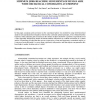Free Online Productivity Tools
i2Speak
i2Symbol
i2OCR
iTex2Img
iWeb2Print
iWeb2Shot
i2Type
iPdf2Split
iPdf2Merge
i2Bopomofo
i2Arabic
i2Style
i2Image
i2PDF
iLatex2Rtf
Sci2ools
IJCSS
2006
2006
Minimum Jerk Reaching Movements of Human Arm with Mechanical Constraints at Endpoint
In this paper, minimum jerk movement on the constrained sphere was studied by using both theoretical analysis and experimental investigation. Based on the constraint optimal principle, it was obtained that the trajectory of the minimum jerk movement on the surface of sphere should be a geodesic. Experiments used a robot especially designed for studies of human-machine interactions to evaluate movements on a virtual surface. Experiments revealed that the nervous system tries to learn and represent a constrained surface so it can move most efficiently (i.e. move along a geodesic) with practice, and that subjects can generalize this knowledge to nearby locations not yet visited.
| Added | 12 Dec 2010 |
| Updated | 12 Dec 2010 |
| Type | Journal |
| Year | 2006 |
| Where | IJCSS |
| Authors | D. H. Sha, James L. Patton, Ferdinando A. Mussa-Ivaldi |
Comments (0)

